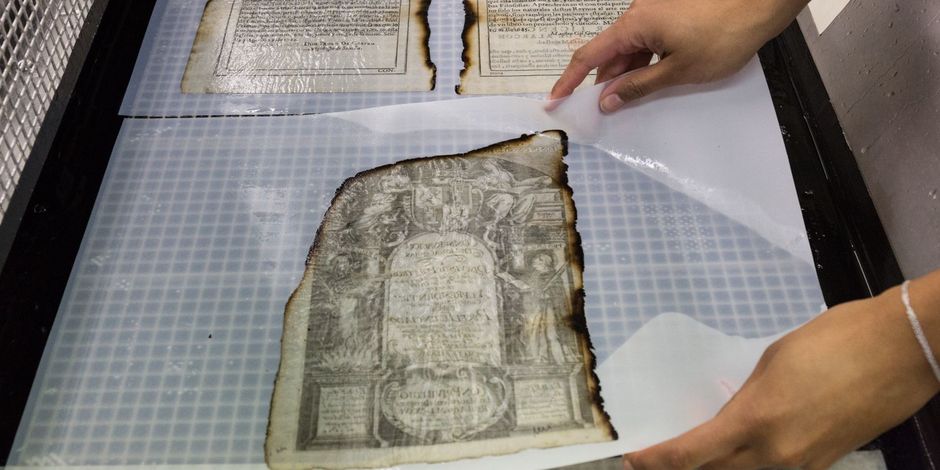Projects of the Klassik Stiftung Weimar are funded by the European Regional Development Fund (ERDF) and the Free State of Thuringia, represented by the State Chancellery of Thuringia, Department of Culture and the Arts.

After the fire
Mass conservation methods for repairing the fire damage
On 2 September 2004, the day of the fire, 196,000 books were stored inside the Historic Library, another 800,000 were located in four external stacks. Staff and volunteers succeeded in salvaging 28,000 volumes unscathed from the Rococo Hall. Fifty thousand books were lost to the flames, and another 118,000 were damaged. The special website Brandverluste provides a searchable database listing all the volumes lost in the fire.
Out of the 118,000 damaged books, 56,000 were found to be contaminated with soot, smoke and other pollutants. Some 62,000 books exhibited minor to irreparable damage by extinguishing water, heat and fire. These included 37,000 volumes with damaged bindings, and 25,000 items recovered from the burnt rubble. These so-called “ash books” comprise a total of 7.5 million individual sheets.
From 2004 to 2018, all 56,000 soot- and smoke-damaged books were cleaned, decontaminated and conservationally treated. The 37,000 books with damaged bindings have almost been completely restored. Out of the 7 million ash book sheets, a total of 1.5 million have been selected for restoration. So far, our curators have succeeded in restoring 860,000 sheets.
Twenty-seven workshops around Europe are participating in the book restoration efforts. In order to guarantee the quality of the measures, detailed descriptions of the working process were drafted, restoration protocols were introduced, and only tested materials were distributed to the workshops.
In 2004 there were no methods to restore and conserve such an enormous mass of fire-damaged books. With the generous support of the Vodafone Stiftung Deutschland, the Herzogin Anna Amalia Bibliothek set up Germany’s first restoration workshop for fire-damaged documents in 2008 in Weimar-Legefeld. Applying a standardised process, the workshop has been restoring approximately 60,000 sheets every year. With financing provided by the Volkswagen Stiftung, curators are working hard to digitalise the ash books. For a closer look at the activities of the restoration workshop, watch our film “Saving Weimar’s Ash Books”.
Saving Weimar's ash books
The work in the Weimar-Legefeld restoration workshop
After the fire, the library immediately consulted with the scientific community and initiated several research projects headed by an international team of experts.
The completed model projects which received funding from the Coordination Office for the Preservation of Written Cultural Assets (KEK) are:
Conservation of historical silk bindings (2016)
HAAB researchers have been collaborating with the Institute of Chemistry at the University of Natural Resources and Life Sciences in Vienna on the “Use of nano- or micro-fibrillated cellulose for stabilising and conserving historic paper” since 2018.
In cooperation with the Faculty of Architecture, Engineering and Conservation at the Hildesheim University of Applied Sciences and Arts (HAWK), the HAAB developed the exhibition “Restoration after the Fire – Salvaging the Books of the Herzogin Anna Amalia Bibliothek” in 2004 and produced the accompanying exhibition book. (in catalogue)
Our next step is to prepare a mass digitalisation procedure using multispectral photography, image processing and pattern recognition in order to improve the legibility of the fire- and water-damaged manuscripts.
The restoration workshop also serves as an academic training facility for students.

